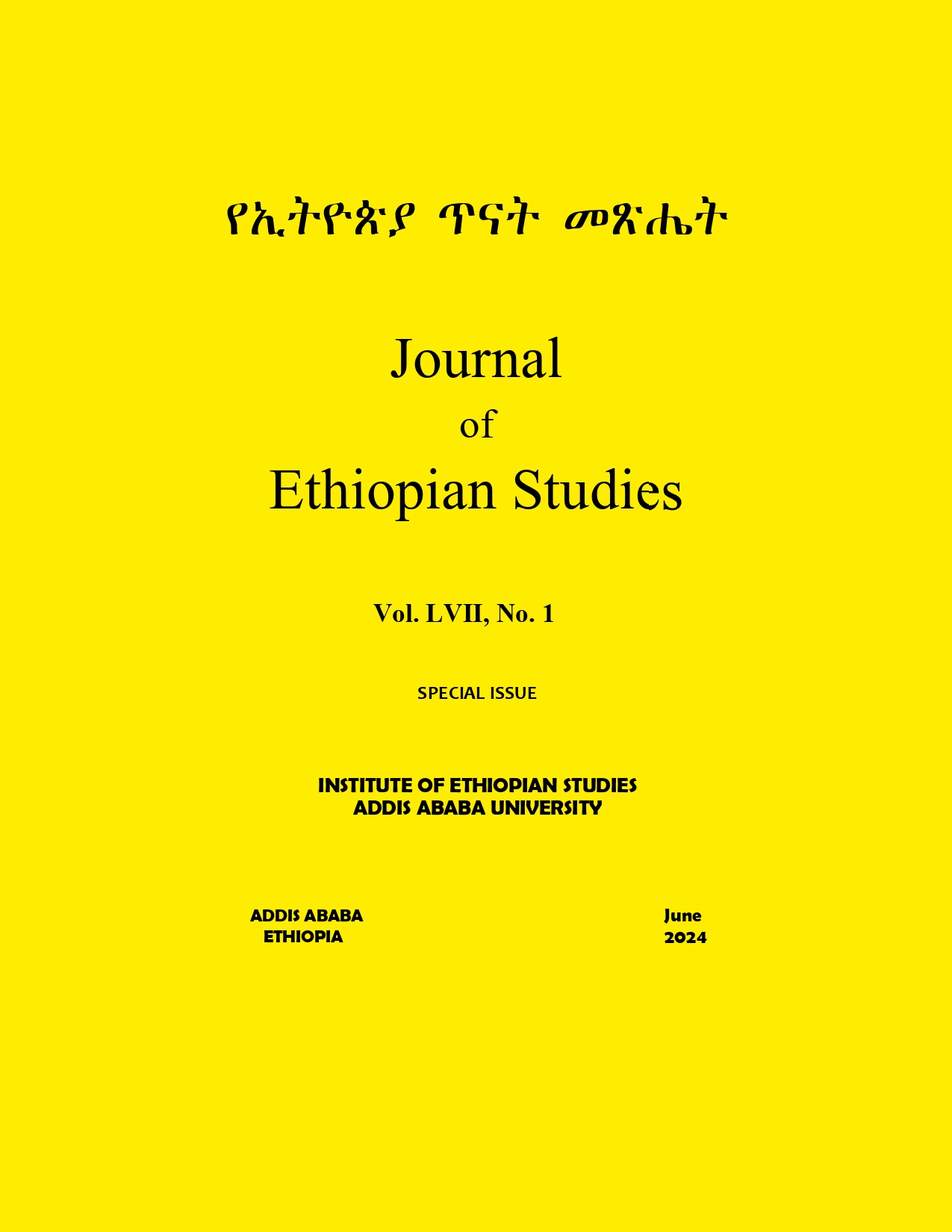መጽሐፈ ሐተታ ዘርዐ-ያዕቆብ አክሱማዊ? የዳዊት መዝሙር እንደማስረጃ
The inquiries of Zera Yaqob of Aksum: The Psalter as an evidence
Keywords:
ሐተታ፣ ዘርዐ-ያዕቆብ፣ ጁስቶ ዳ ኡርቢኖ፣ የዳዊት መዝሙር፣ ምዕራፍ, Hateta, Zara Ya'eqob, Giusto d’ Urbino, Psalms, Me'erafAbstract
ዓለማየሁ ሞገስ የተባሉ ጸሐፊ በ1961 “ሐተታ ዘዘርዐ-ያዕቆብ ኢትዮጵያዊ ፈላስፋ” በሚል ርእስ ለቢኤ ድግሪ ማሟያ የቀረበ ጥናት አሳትመው ነበር። በዓለማዮሁ ሞገስ ስራ መጽሐፈ ሐተታ ዘርዐ-ያዕቆብና የዳዊት መዝሙር ጥብቅ ትስስር እንዳላቸው በማያሻማ መንገድ ቢገለጽም ትስስሩ ግን በሚገባ ተዘርዝሮ የተብራራ አይደለም። ስራው ከመጽሐፈ ሐተታ ዘርዐ-ያዕቆብ ኹለቱ ቅጂዎች በአንዱ ብቻ በማትኮር የተጻፈም ነው። ሌላው ደግሞ ስራው የየመጽሐፈ ሐተታ ዘርዐ-ያዕቆብ ጸሐፊ ሳይኾን አይቀርም ተብሎ የሚታማው ጁስቶ ዳ ኡርቢኖ የዳዊት መዝሙር ዕውቀት ፈጽሞ አይዳስስም። ይኽ ጽሑፍ እነዚኽ ክፍተቶች ለመቅረፍ ሰርተዋል። ለዚኽም ጽሑፉ የዳዊት መዝሙር በመጽሐፈ ሐተታ ዘርዐ-ያዕቆብ የተጠቀሰበት መንገድ የኢትዮጵያ ሊቃውንት የዳዊት መዝሙር ንባብ ከሚጠቅሱበት ባህል ጋር ማነጻጸር፣ በመጽሐፈ ሐተታ ዘርዐ-ያዕቆብ የሚገኙ የዳዊት መዝሙር ንባቦች የቀረቡበት ዓውድ የኢትዮጵያ መጻሕፍት ፈለግ ተከትሎ እንደኾነ መፈተሽ፣ በመጽሐፈ ሐተታ ዘርዐ-ያዕቆብ የሚገኙ የዳዊት መዝሙር ንባቦች ምንጮች ሊኾኑ ከሚችሉ የኢትዮጵያ ጸዋትወ ዜማ ወይም ቅኔ መጻሕፍት ማመሰካከር የመሳሳሉ ዓይነተኛ የጥናት ዘዴዎች ተጠቅመዋል። ከተጠቀሱት ዓይነተኛ የጥናት ዘዴዎች ትንተና በመነሣትም ጽሑፉ በመጽሐፈ ሐተታ ዘርዐ-ያዕቆብና የዳዊት መዝሙር ያለ ትስስር ጥብቅና ጥልቅ እንደኾነ አረጋግጠዋል። ትስስሩም ምዕራፍ በመባል በሚታወቀው የጸዋትወ ዜማ ድርሰት እንደሚመሰረት በዝርዝር ተገልጸዋል። ከጽሑፉ ትንተናዎች ማየት እንደሚቻለው ደግሞ የመጽሐፈ ሐተታ ዘርዐ-ያዕቆብ ጸሐፊ የዳዊት መዝሙር ዕውቀት፣ ፍቅር እና ክብር በጁስቶ ዳ ኡርቢኖ የታወቁ ኹሉም ስራዎች ፈጽመው አይገኙም፤ በሕይወቱ እና የስራ ፍሬዎቹም ጭራሽኑ አይታዩም። እነዚኽ ማስረጃዎች ሲመዘኑ ጁስቶ ዳ ኡርቢኖ የመጽሐፈ ሐተታ ዘርዐ-ያዕቆብ ጸሐፊ አድርጎ መውሰድ ፍጹም አዳጋች ያደርጓል። ይኽ ደግሞ በመጽሐፈ ሐተታ ዘርዐ-ያዕቆብ በበቂ መንገድና በሚገባ አጽንዖት የተገለጸውን የዘርዐ-ያዕቆብ ኢትዮጵያዊነት ያጸናል።
The inquiries of Zara Yaeqob (hereafter referred to as the Hateta) is an autobiographical text copied from parchment and sent to Antoine D'Abbadie of France by an Italian monk named Giusto d’ Urbino, who lived in Ethiopia from 1847 to 1855. However, the original parchment from which the copy was made has yet to be found. Consequently, the authenticity of the Hateta and the true identity of its author have long been subject to debate. Although the Hateta is presented as an autobiography, it is thoroughly interwoven with Psalm verses from the Psalter. Throughout the Hateta, the Psalter is quoted extensively and referenced in depth to the extent that it is sometimes treated as a Psalter itself. This strong link between the Hateta and the Psalter formed the basis of Alemayohu Moges’s pioneering work, Hateta Zara Yaeqob: Ethiopian Philosopher (1968). While Alemoyohu Moges’s work was novel in opening an important new line of inquiry, it lacked rigor in demonstrating the supposed textual link between the Hateta and the Psalter. His analysis also relied solely on manuscript Eth. Abb. 215, and he did not address Giusto d’ Urbino’s potential authorship of the Hateta. This study addressed these gaps by thoroughly exploring the link between the Hateta and the Psalter using both Eth. Abb. 215 and Eth. Abb. 234 manuscripts and examining Giusto d’ Urbino’s knowledge or use of the Psalter in his scholarly contributions. The analysis revealed that most of the Psalm verses appearing in the Hateta are also found in an Ethiopian book called Me’eraf. In contrary, Giusto d’ Urbino’s scholarly output do not indicate a comparable depth of knowledge, respect or love for the Psalter or Psalms as that displayed in the Hateta. In light of these evidence, it is reasonable to conclude that the Hateta is uniquely Ethiopian and that its true author hailed from Axum.


